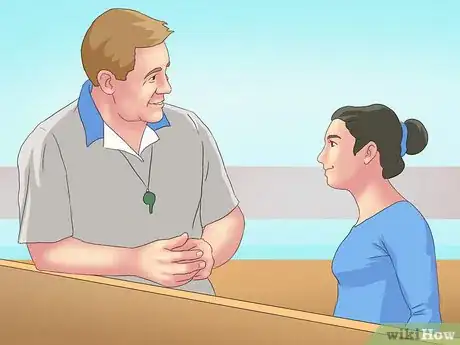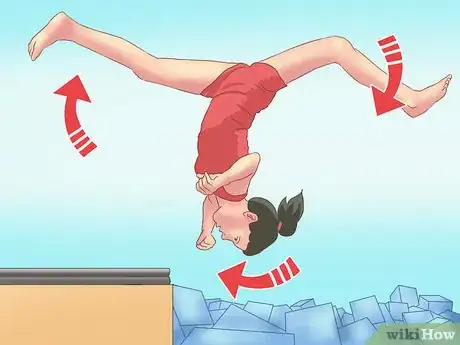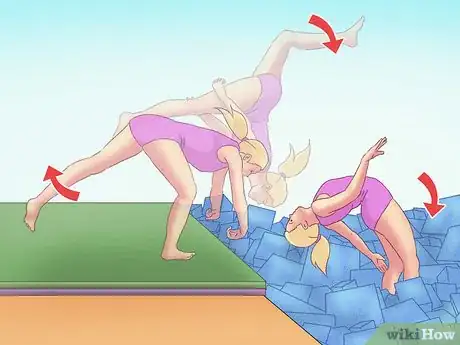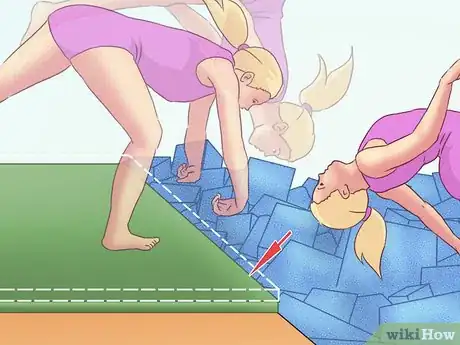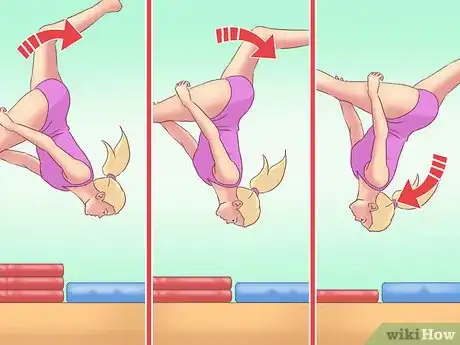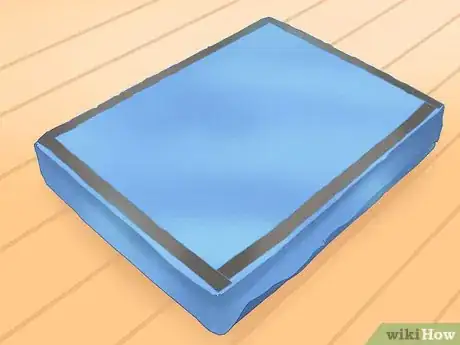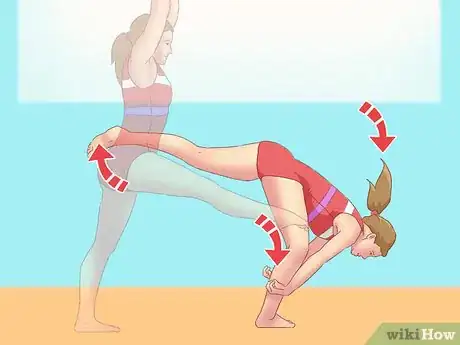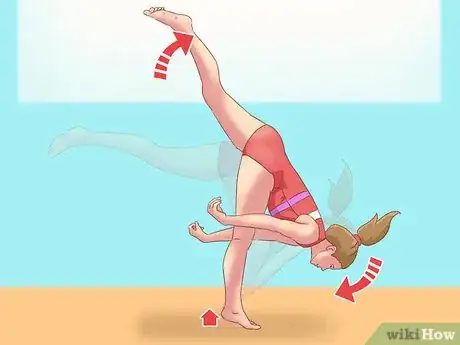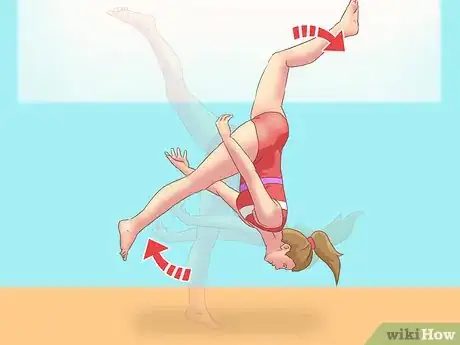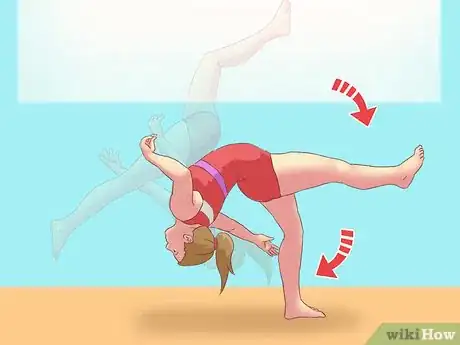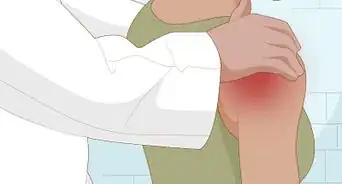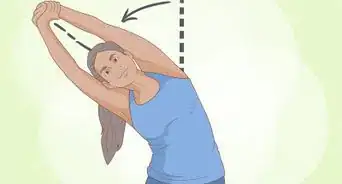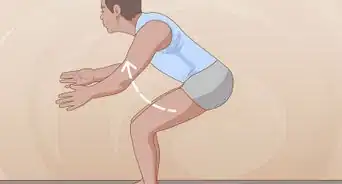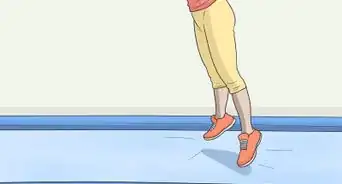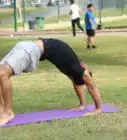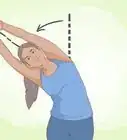This article was co-authored by wikiHow Staff. Our trained team of editors and researchers validate articles for accuracy and comprehensiveness. wikiHow's Content Management Team carefully monitors the work from our editorial staff to ensure that each article is backed by trusted research and meets our high quality standards.
This article has been viewed 60,029 times.
Learn more...
A front aerial is an advanced gymnastics skill that is essentially a front walk-over that doesn't use hands for support. To pull this move off, you'll need a fair amount of leg and core strength, but you'll also need a decent amount of leg and back flexibility, too. But once you've mastered it, you can use the front aerial to spice up your cheerleading routine, or even to impress friends and teammates. It is a cool skill, to do, and with practice and the right precautions, you'll safely master it in no time.
Steps
Familiarizing Yourself with the Motions
-
1Master the prerequisites. Gymnastics skills build off of each other, and before you attempt the front aerial, you'll want to have mastered similar, more basic skills. This includes the front walk-over, the front handspring step-out, and the side-aerial.[1]
- These skills involve attributes and motions comparable to the front aerial, and mastery will result in better execution.
-
2Ask your coach if you're ready. Unless you have learned the right prerequisites, doing a front aerial without the proper equipment and supervision could result in serious neck or back injury. Your coach is the person who knows your skill level best, so ask them their opinion and advice.Advertisement
-
3Prepare to simulate the motion. To help your body become accustomed to the uncanny sensation of doing an entire frontward revolution without the use of your hands, you're going to practice the motion into a foam pit. Stack two panel mats at the edge of the floor, near the foam pit.[2]
- If your gym doesn't have a foam pit, talk with your coach and see if there's one nearby you can use for practice..
-
4Perform the motion by splitting your legs and tumbling forward. Stand on one foot, push off by bending at the knee and driving with your leg, flip forward by leaning in and splitting your legs, and finally allow yourself to fall into the foam pit. This will help your body acclimate to the sensation of being upside down while unsupported and in motion.
- Your distance from the foam pit will depend on your height. Be sure you are close enough to the foam pit that you clear its lip and the intervening space in the course of your tumble. Generally, about six inches (15¼ cm) should be sufficient.
- Repeat this process several times until you are comfortable with the sensation.
-
5Remove a mat and practice into the foam pit again. The less vertical assistance you have from the mats, the more you will have to engage your legs and core to launch your body through the air. The fewer mats you use, the more like the real thing your practice will become.
-
6Flip on a trampoline or tumble track. Your flip differs from a front aerial in that the an aerial requires you to keep your legs extended, which will slow your rotational velocity. Approach your flip at a run and then execute. Once you feel comfortable, try to step into a front aerial.
-
7Attempt a front aerial on the floor with height aids. If you are comfortable with the previous drills and mastered the prerequisite skills, as your coach if you're ready to try a front aerial on the floor with height assistance. Take an eight inch mat and put it on a soft, padded gymnastics floor or carpet. Then stack three panel mats on top of each other, and another three behind those.[3]
- Stand on the panel mats. Push off, flip, and land on the eight inch mat. Try to stick your landing!
- Lower height by removing mats once you perfect this motion. Then do it with two panel mats, one panel mat, then no panel mats!
-
8Protect yourself from injury while learning. Before trying to do a front aerial on plain floor, get a really thin mat, or a "pit pillow," and place it on bouncy floor or regular floor. Start off from the floor, and aim to land on the thin mat.
Executing a Front Aerial without Assists
-
1Get a spot. Your coach should be there for your first few attempts at an unaided front aerial for two reasons. Firstly, you'll want him to spot you while you master the move to prevent you from injuring yourself while learning. Secondly, he'll be able to give you pointers to improve your front aerial and make executing it easier.[4]
-
2Assume your start position and begin your forward motion. You should raise your arms up to your ears and lift your leading leg to step forward. Step into a lunge, bending your front leg to prepare to jump. Lower your shoulders to about the height of the knee of your forward leg and ready your arms to drive backward.
-
3Drive back with your lower body. You should drive the heel of your back leg toward the ceiling. As you begin to push through the motion, straighten your base leg and swing back with your arms.[5]
-
4Lift your upper body. While your back heel and arms are reaching the highest/farthest point possible of your drive, you should also lift with your hips and chest. Finish the motion by pushing and jumping off your base leg, all the way through your foot.[6]
-
5Land on your leading leg. You'll need to stay tight and maintain eye contract with the floor while you drive your leading heel and arms through the motion. Keep your head back as your leading leg begins to reach the floor.[7]
- As your leading foot finds the floor, your trailing leg will follow.
- Keep your form tight and use your following leg as a counter-weight to pull your torso upright.
- Keep your head back throughout.
-
6Return to the neutral position and step forward. As you approach the upright position you will again find your balance. Your arms should finish circling by your ears as your trailing leg descends. Then, step forward onto your trailing leg in a controlled fashion to complete the skill.[8]
Community Q&A
-
QuestionHow do I keep myself looking at the ground the whole time?
 Community AnswerPut a piece of tape on the ground and look at the tape as you're doing your front aerial. It will keep your back arched and it will be easier to land.
Community AnswerPut a piece of tape on the ground and look at the tape as you're doing your front aerial. It will keep your back arched and it will be easier to land. -
QuestionHow do I keep my legs straight in a front aerial?
 Community AnswerLock your legs, point your toes, and bring your arms up by your side. It helps to keep your eyes on the ground.
Community AnswerLock your legs, point your toes, and bring your arms up by your side. It helps to keep your eyes on the ground. -
QuestionHow do I get over the fear of doing it?
 Community AnswerFear is normal. When you're practicing, have an instructor or another trusted person nearby. Think through the move before you perform it. The more you practice, the quicker you will get over the fear of doing it.
Community AnswerFear is normal. When you're practicing, have an instructor or another trusted person nearby. Think through the move before you perform it. The more you practice, the quicker you will get over the fear of doing it.
Warnings
- Avoid attempting this skill if you have an ankle, hamstring, thigh, wrist, or knee injury.⧼thumbs_response⧽
- Especially when learning the mechanics of this skill, it can be dangerous. Don't try it without an experienced spotter, because there is a possibility of falling on your head or neck, which could cause serious injury.⧼thumbs_response⧽
- Get your coach's approval before learning this move.⧼thumbs_response⧽
- Don't do this trick at home, unless you have soft mats, and carpet underneath the mats!⧼thumbs_response⧽
References
- ↑ http://www.nssaf.ca/sites/default/files/files/Tumbling%20Levels%201-4%20Study%20Guide(1).pdf
- ↑ http://www.drillsandskills.com/skills/floor/
- ↑ http://www.drillsandskills.com/article/10
- ↑ https://www.healthychildren.org/English/healthy-living/sports/Pages/Gymnastics.aspx
- ↑ http://www.nssaf.ca/sites/default/files/files/Tumbling%20Levels%201-4%20Study%20Guide(1).pdf
- ↑ http://anthonymychal.com/2014/08/aerial/
- ↑ http://www.nssaf.ca/sites/default/files/files/Tumbling%20Levels%201-4%20Study%20Guide(1).pdf
- ↑ http://anthonymychal.com/2014/08/aerial/

